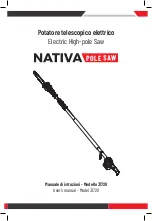
OPERATION
1
. Ensure that the riving knife is adjusted so that (Fig.
6
):
A
. The distance between the riving knife (
11
) and the
toothed rim of the saw blade is under
5
mm.
B
. The toothed rim does not extend more than
5
mm
beyond the lower edge of the riving knife.
2
. The riving knife should always be used except when
making a plunging cut in the middle of a workpiece.
ADJUSTING THE DEPTH OF CUT (FIG. 7A, 7B,
8, 9)
1
. To adjust the depth of cut, loosen the depth
adjustment knob (
12
). (Fig.
7A
)
2
. Slide the base plate (
13
) to the desired depth using
the depth adjustment lug (
21
) and retighten the knob
securely. (Fig.
7B
)
3
. The depth of cut (
14
) can be determined by the depth
scale (
15
) or by measuring the distance by which the
blade protrudes from the base plate. (Fig.
8
and
9
)
ADJUSTING THE CUTTING ANGLE (FIG. 10A,
10B)
1
. The cutting angle may be set to any position between
0
° and
45
°. (Fig.
10A
)
2
. Loosen the bevel adjustment knob (
16
) at the front of
the tool and move the base plate to the desired angle
using the bevel scale (
17
). (Fig.
10B
)
3
. Once the angle has been set, be sure to retighten the
bevel adjustment knob firmly.
TRIGGER SWITCH (FIG. 11)
This tool is started and stopped by squeezing and
releasing the trigger switch (
18
). To prevent the tool
from being started accidentally, the trigger can only
be operated if the safety button (
19
) is depressed
first. The safety button can be depressed with the
thumb leaving the other fingers free to squeeze the
trigger switch. It is not necessary to maintain pressure
on the safety button once the trigger switch has been
depressed.
OPERATING INSTRUCTIONS (FIG. 12)
DANGER!
Keep hands away from the cutting area when
operating the tool. Keep the cord away from the
cutting area and position it so that it will not get
caught on the workpiece during the cutting
operation.
When cutting, use steady and even pressure
(DO
NOT FORCE)
in order to obtain a uniform cut. Cut at
a speed suited to the workpiece. (Cut slowly if the
workpiece is hard.) Inspect the saw blade frequently
and replace or sharpen it if dull to avoid overloading
the motor.
CUTTING POSITION (FIG. 13A, 13B)
When cutting a workpiece at
0
°, use point "
A
" of the
base plate line guide (
20
) and move the saw along
the pencilled line you have drawn. When cutting at
45
°, use point "
B
". This line guide shows an
approximate line of cut. Make a sample cut in scrap
lumber to determine the actual line of cut.
CAUTION!
When ripping, the rip fence should only touch the
workpiece slightly. Do not force.
MAINTENANCE
A
fter use, check the tool to make sure that it is in top
condition.
We recommended that you take this tool to an
A
uthorised Ryobi Service Centre for a thorough
cleaning and ubrication at least once a year.
Do not make any adjustments while the motor is
running.
A
lways disconnect the power cord from the socket
before changing removable or expendable parts
(blade, bit, sandpaper, etc.), lubricating or working on
the saw. Keep handles clean and free from oil and
grease.
If the supply cord is damaged, it shall be replaced by
the manufacturer or its service centre or similar
qualified person in order to avoid a hazard.
WARNING
For greater safety and reliability, all repairs
should be performed by an
A
uthorised Ryobi
Service Centre.
LIVETOOL INDICATOR
TM
This tool features a livetool Indicator
TM
(
22
) which
illuminates as soon as the tool is connected to the supply.
This warns the user that the tool is connected and will
operate when the switch is pressed.
5
ECS12519-Eng.qxd 10/10/04 2:16 PM Page 5




























